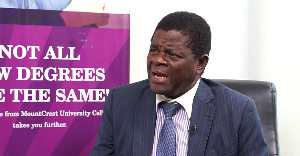Opinions of Saturday, 29 November 2008
Columnist: Prempeh, Akwasi
Corruption in Public Institutions in Ghana
The destructive phenomenon of corruption and its apparent pervasiveness, both perceived and experienced, is perhaps best described by Kofi Annan as being especially destructive in developing countries with their delicate economic situations. It has critically hobbled and skewed Africa’s development. There is no point in pretending that this is not true. Addressing the problem of corruption requires targeting both payer and recipient … African governments in particular must … make the fight against corruption a genuine priority. The costs of not doing so are very high in lost resources, lost foreign investment, distorted decision-making, and failing public confidence. (Source, “Global integrity in a changing world,” speech by Mr. Kofi Annan, UN General Secretary at the 9th International Anti-Corruption Conference, Durban, South Africa, 1999).
The definition of corruption used for this article is the commonly accepted “misuse of entrusted power for private benefit.” From this definition, corruption may be categorized under three headings. The first is incidental corruption. This is small-scale. It involves junior public officials, such as policemen or customs officers; it produces profound public alienation; and it is often hard to curb.
Secondly, there is systematic corruption. This is corruption that affects, for example, a whole government department or parastatal. Recent news reports, for example, indicate that the newly initiated school feeding programme and the Metro Mass Transit have been seething with misappropriation of funds, pilfering, and other malfeasances. This type of corruption, for instance, caused the collapse of the Omnibus Service Authority (OSA) in the 1980s. This type of corruption can have a substantial effect on government revenues; it may divert trade and/or development; it can only be dealt with by sustained reform.
Thirdly, there is systemic corruption, that is, kleptocracy or government by theft. In this situation honesty becomes irrational, and there is a huge developmental impact. A classic example is the now defunct Ghana Airways. The following are other examples of systematic and systemic forms of corruption.
False names (or ghost workers) on a payroll.
The process of public procurement that gives wide scope for corruption (through paying bribes to secure contracts, over-priced contracts, insider dealing, claiming payment for goods which have not been delivered, etc.).
Privatisation offers scope for embezzlement as state-owned assets may be under-priced and then bought by insiders or sold to outsiders for commission.
A more pervasive form of systematic and systemic corruption is institutional in nature. Institutional features, such as red tape, lack of information, and inadequate enforcement of regulations are, if not indicative of corruption, definitely a factor that increases the likelihood of corruption in public institutions. In public finance for example, the lack of effective access to information provisions (which would ensure taxpayers are aware of their rights and less exposed to discretionary treatment by corrupt officials) and the absence of credible review mechanisms increase the risk of corrupt dealings. “Personal contact” between tax officials and tax payers, and discretion in the interpretation of unclear regulations, are conducive to illicit practices. The absence of measures designed to maintain the integrity of staff, such as the promotion and enforcement of ethical standards, merit-based recruitment and promotion procedures and regular staff rotation schemes to prevent the building of networks, increases the likelihood of staff exploiting corrupt opportunities.
One area of institutionalized corruption in
Table 1: Types of real estate in the Kumasi Metropolitan Assembly area - 2005.
| Type of Real Property | Number | Estimate of Property Tax to be collected in 2005 (cedis) | |
| Residential | | | |
| 1st Class | 17,198 houses | 1,600,000,000.00 | |
| 2nd Class | 16,811 houses | 1,000,000,000.00 | |
| 3rd Class | 12,200 houses | 350,000,000.00 | |
| Unassessed Residential of 1st, 2nd, & 3rd class categories | | 680,000,000.00 | |
| Total Estimated Revenue (Residential) | 3,630,000,000.00 | ||
| Commercial | | | |
| 1st Class | | 600,000,000.00 | |
| 1st Class | Mixed Residential/Commercial | 450,000,000.00 | |
| 2nd Class | | 350,000,000.00 | |
| Hotels with varying assessed values | 148 | 150,000,000.00 | |
| Financial Institutions | 16 | 150,000,000.00 | |
| | 1 | 200,000,000.00 | |
| Total Estimated Revenue (Commercial) | 1,900,000,000.00 | ||
| Industrial | | | |
| Timber Firms | 64 | 150,000,000.00 | |
| Other Firms | 450 | 600,000, 000.00 | |
| Total Estimated Revenue (Industrial) | 750,000,000.00 | ||
| Government Property and Parastatals | | 45,850,000.00 | |
| Arrears on Government Property and Parastatals | | 15,000,000.00 | |
| Total Estimated Revenue (Government) | 60,850,000.00 | ||
| Arrears of all Property Tax Payments | | 200,000,000.00 | |
| GRAND TOTAL (All Properties) | 6,540,850,000.00 | ||
When Fifimu finished the computerization project a trial run was made with property rates based on 1991 values of real estate in the
The commercial real estate properties were categorized into 1st Class (C1), 2nd Class (C2), 3rd Class (C3), other category covering hotels with various assessed values (148 in total), financial institutions of various assessed values (16 in total), Ghana Telecom (GT). The industrial real estate properties had 64 timber firms with varying assessed values, and there were 450 other industrial properties of varying assessed values. These figures are presented in Table 1 above.
The revenues estimated to be collected from these various real properties for 2005 were as follows: Residential property: 3,630,000,000.00 cedis; commercial property: 1,900,000,000.00 cedis; industrial property: 750,000,000.00 cedis; government: 60,850,000.00 cedis; and arrears: 200,000,000.00 cedis. This gave a total estimate of 6,540,850,000 cedis to be collected in property taxes for 2005 without the computerization project (see Table 1 above). Estimated Common Fund for KMA from the Central Government for 2005 was 9.5 billion cedis.
Using the receipts that KMA produced as actual money collected in 2004, the computer experts who installed the computerization project found out that there was some discrepancy in the figures KMA reported. In one instance, KMA reported an actual revenue total collection of 2,687,238,330.00 cedis as compared to actual receipts figure of 4,266,931,618.00 cedis. A trial run by the computerized system indicated that for 2005, KMA could collect a total of 86,187,302,494.19 (about 86.2 billion) cedis. With this potential to generate this revenue from property taxes alone, why was it necessary for KMA to expect to receive 9.5 billion cedis from the Central Government for 2005?
The whole computerization project was designed to give information to the taxpayer and incentive to pay on time in order to avoid penalty charges for late payment. For example, the computerization project assigned clear account billing numbers. For example, in the Asokwa Sub-Metro division, the council area of Oforikrom House Number 1 BLT T was assigned a billing account number (AB 18020014) that was computer generated and sent out to property tax payers. This Oforikrom property was classified as 2nd Class Residential with assessed 1991 value of 19.6 million cedis. The rate impose was set at 0.0049 with total amount of 96.04 thousand cedis due to KMA in 2005.
In the Manhyia Sub-Metro division, the council area of Suame Town Council House Number 14 BLT B at Tarkwa Makro was assigned a billing account number (MA 12109033) that was computer generated and sent out to the property tax payer. This Suame Town Council property was classified as 2nd Class Residential with assessed 1991 value of 224,250.00 cedis. The rate impose was set at 0.0065 with total amount of 379.25 thousand cedis due to KMA in 2005. This amount included arrears of 155,000 cedis.
As soon as the computerization project unearthed some inherent weakness stemming from institutionalized corruption at KMA, the first thing the top officials of the Property Tax Unit required of the computerization experts was the setting aside of the whole computerization project because the system was “too complicated.” What was the alleged complication about? Why would the KMA pay for computerization only for some officials of the KMA to allege the computerization was too complicated? Did these officials notice any improvement in their work that the computerization was making possible? Why was the 2005-2006 computerization project abandoned only for a new contract to be awarded to another ICT company owned/controlled by Zoom Lion (a waste management company)? How much did it cost the KMA to award the computerization project two times in the past three years? What is the guarantee that the staff at the staff at the Property Tax Unit would not declare the new computerization project “too complicated?” When will the computerization project be up and running so that the taxpayer would derive benefits with respect to improved services in the municipality?
In talking to assembly men as well as taxpayers, I have found that the Property Tax Unit of KMA had too much too discretionary powers to determine how much a property tax payer would actually pay. For example, for a house categorized as 1st Class Residential, the tax collector could come to agreement with the taxpayer for the taxpayer to pay for 2nd Class Residential rate arbitrary set by the tax collector. The tax collector would the turn around and report the house as 3rd Class Residential on the KMA books.
There did not exist regular staff rotation from one Sub-Metro to another nor did the Tax Unit encourage and promote inter-departmental transfers to prevent the possibility of the Tax Unit staff building a social network among the taxpayers in order to favour some taxpayers. Over the years the tax collectors had developed a system of patronage in which staff members are given support when they are bereaved. In our instance, masi to Enchi.all the funeral expenses incurred by a staff member were paid for by the Tax Unit. The funeral was held in Enchi in the Western Region and the Tax Unit paid for expenses for food, transportation, and drinks all the way from Ku
Conclusion
In 1969, the NLC announced a “national crusade” against corruption in order to “eliminate all forms of corruption from Ghanaian life.” This was coming from a “liberation council” whose members such as Afrifa (he appropriated for his personal use sections of Ejura State Farms which he named as Okatakyie Farms) and Ankrah (he was nabbed in bribery web of Arthur Nzeribe) were themselves deep in corruption quagmire. Ankrah was later to resign in April 1969 when it was revealed that he had illicitly received from various foreign firms sums of money totaling $30,000.
In March 1970, the Busia Administration set up a five-man Commission of Enquiry into Bribery and Corruption in
If Ghanaians have become cynical about politicians and their promises to root out corruption in the country, it is because such probes and slogans have apparently not brought about much improvement in the quality of public administration in the country. Some people even argue that there are some beneficial results of corruption. Nepotism, for example, is popularly respected and even expected. A story is told of someone who set up a hospitality business in
The evidence from the Property Tax Rate Unit of the Kumasi Municipal Assembly is a classic example of the popular 'paradox of poverty in the midst of plenty.' The KMA has the potential to raise about 86 billion cedis from property tax rate through a more efficient billing and collection system. Yet KMA turns to the central government for 9.6 billion cedis from the Central Fund as KMA is “poverty stricken” because it can only collect less than 5 billion cedis. The potential to collect 86 billion cedis was based on 1991 property values of real estate. The 1991 figures represent an under-assessment of the real values of property in
Why was it possible for the ICT experts undertaking the computerization project to uncover discrepancies between the amounts declared as collected and the amounts totaled from the receipts, yet auditors did not catch such discrepancies?
Akwasi Prempeh (ohenenana.prempeh@gmail.com) is a Middle School Leaving Certificate (Standard Seven) scholar, a Proud Verandah Boy, and Singing Band Master at the local church in the


















